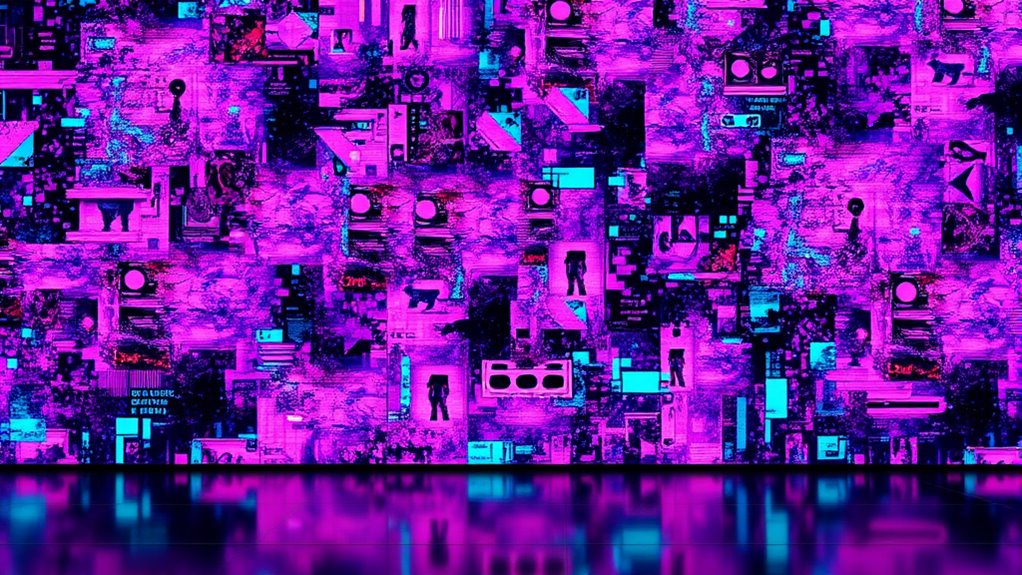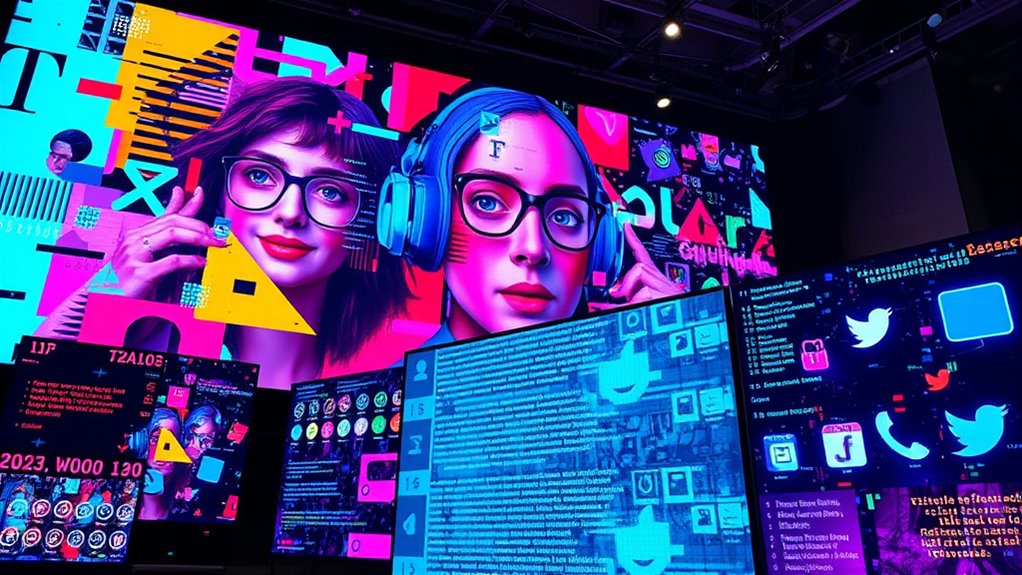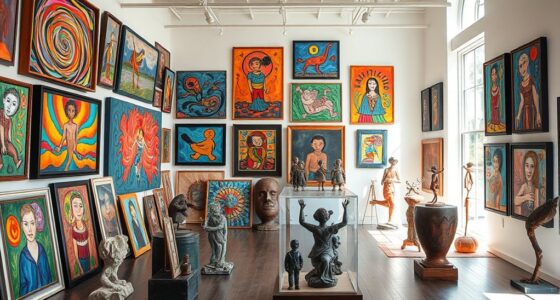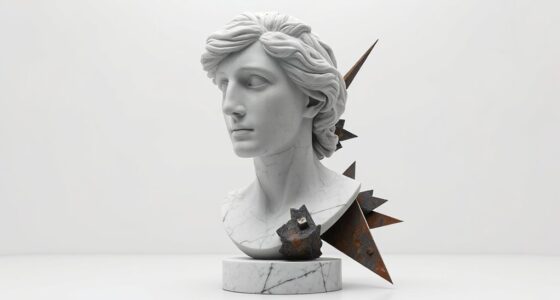Post-internet art explores how digital culture transforms visual expression and societal perspectives. You’ll notice it often uses glitch effects, pixelation, and layered visuals that challenge traditional beauty standards. It comments on issues like online identity, surveillance, and data privacy, reflecting both the chaos and connectivity of digital life. As you explore further, you’ll uncover how this art movement encourages critical reflection on the impact of technology on society and personal experience.
Key Takeaways
- Post-Internet art employs digital aesthetics like glitch effects and pixelation to create visually striking, hybrid works blending virtual and physical realms.
- It functions as a cultural critique, examining online identity, social media influence, surveillance, and data privacy issues.
- The style emphasizes immediacy, hyper-stimulation, irony, and incorporates memes, collages, and interactive installations.
- It explores themes of connection versus division, democratization versus exploitation within digital culture.
- Post-Internet art reflects how digital aesthetics shape perceptions of reality and influence societal norms in the digital era.

Post-Internet art is a movement that reflects how the internet has transformed contemporary culture and creative expression. You’re likely to notice how artists harness digital aesthetics to create visually striking works that blur the lines between the virtual and physical worlds. This art form often relies on the rapid, fragmented nature of online content, using glitch effects, pixelated images, and layered visuals to evoke a sense of digital chaos. Through these aesthetic choices, artists challenge traditional notions of beauty and craftsmanship, instead embracing the raw, sometimes unsettling, qualities of digital imagery. As you explore post-Internet art, you’ll see how it mirrors the aesthetic trends born from the digital age, emphasizing immediacy, accessibility, and a certain glossy, hyper-stimulating quality that’s distinctively online.
But it’s not just about style; this movement also serves as a powerful tool for cultural critique. You’re encouraged to look deeper at how online environments shape identity, community, and power dynamics. Post-Internet artworks often comment on the pervasive influence of social media, digital commodification, and the way information is consumed and manipulated in the digital sphere. These works question the authenticity of online interactions, highlighting issues like surveillance, data privacy, and the superficiality of digital personas. By doing so, artists provoke viewers to reflect on the cultural implications of living in a hyper-connected world. They invite you to contemplate how digital aesthetics influence your perception of reality, and how online culture both democratizes and commodifies creative expression.
You might find yourself confronting the paradox of digital culture: its capacity to connect and divide, to democratize and exploit. Post-Internet art doesn’t shy away from this tension; instead, it amplifies it through layered visuals and provocative themes. The art invites you to see the internet not just as a tool for entertainment, but as a complex landscape that shapes societal values and individual identities. It pushes you to think about how digital aesthetics evolve in response to cultural critique, often using irony or satire to underscore their messages. Whether through memes, online collages, or interactive installations, post-Internet art constantly challenges you to rethink the role of technology in shaping contemporary life. Ultimately, it’s a reflection of how deeply intertwined digital culture has become with everyday experience, urging you to navigate this new landscape with critical awareness and curiosity.
Frequently Asked Questions
How Has Post-Internet Art Influenced Traditional Art Forms?
Post-internet art influences traditional art forms by blending digital aesthetics with physical works, creating hybrid mediums that challenge conventional boundaries. You can see this in how artists incorporate digital imagery, online culture, and interactive elements into paintings, sculptures, and installations. This fusion encourages you to rethink artistic expression, blurring the lines between digital and physical, and expanding the creative possibilities within traditional art, making it more dynamic and interconnected with contemporary technology.
What Are the Main Tools Used by Post-Internet Artists?
Have you ever wondered what tools shape the digital frontier of art? Post-internet artists primarily use digital collage and virtual installation to craft their work. Digital collage allows them to remix images and ideas seamlessly, while virtual installations create immersive online environments. These tools enable artists to blur boundaries between reality and digital space, making their art more interactive and engaging. Isn’t that a fascinating way to reimagine artistic expression?
How Do Viewers Engage With Post-Internet Artworks?
You engage with post-internet artworks through virtual participation, often interacting via digital platforms. Your digital literacy helps you navigate and interpret complex layers of online culture embedded in the art. As you explore these works, you might share them on social media, remix elements, or collaborate online, making your experience active and participatory. This fluid interaction bridges the digital and physical worlds, encouraging a deeper connection with the artwork’s layered, networked nature.
What Ethical Issues Arise in Post-Internet Art?
You’re steering a digital jungle where privacy concerns lurk like shadows, and questions of authenticity shimmer like mirages. Ethical issues in post-internet art revolve around respecting creators’ rights, safeguarding personal data, and ensuring digital authenticity. As you engage, remember that blending art with online spaces can blur boundaries, raising dilemmas about consent and ownership. Stay vigilant, questioning what’s genuine and what’s exploited to honor the integrity of this new artistic frontier.
How Is Post-Internet Art Received in Different Cultural Contexts?
You’ll find that cultural reception of post-internet art varies markedly across different regions. In some places, it’s celebrated for its innovation and commentary, resonating with global perspectives. Elsewhere, it faces skepticism or misunderstanding due to differing attitudes toward digital technology and art. As a result, you must consider local customs, values, and digital literacy to understand how post-internet art is received and interpreted worldwide.
Conclusion
As you explore post-internet art, remember that it reflects how our digital world shapes us. This art form blurs boundaries, inviting you to see technology not just as a tool but as a part of life itself. Keep in mind the saying, “The medium is the message”—your understanding deepens as you embrace the interconnectedness of art and the online world. Ultimately, it’s a reminder that in the digital era, everything is intertwined.










